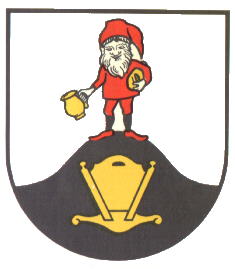Dalldorf (Leiferde)
DALLDORF
State : Niedersachsen
District (Kreis) : Gifhorn
Incorporated into: 1974 Leifferde
| German | blazon wanted |
| English | blazon wanted |
Origin/meaning
The arms were officially adopted on April 22, 1968.
The arms are based on the legend of the Golden cradle in the Wohlenberg. The Wohlenberg is a hill near the village.
The story goes as follows:
In ancient times, the dwarfs lived in Wohlenberg. They dug and searched for gold and silver inside the mountains. They quenched their thirst at the source, the Twargborn (Dwarf Fountain), and when they had filled their jars with water, they walked up the Twargstieg (Dwarf Stairway). Twargborn and Twargstieg can still be seen on Wohlenberg today. One day a girl came and stayed with them. They received her kindly, for it was a child of good people. She helped cleaning the house for the dwarves, cooking food and making the beds. They loved her much. When they returned home from their work one evening, they were very frightened because the girl was ill. And no matter how hard the dwarfs tried, lovingly cared for it and giving it all sorts of healing remedies, their diligent efforts remained in vain. The girl died that same night.
The dwarves were very sad and cried for three days so that it was heard far and wide. Then they took gold and silver from their treasury and formed a golden cradle. In there they put the dead girl. They put the cradle on a wagon, harnessed deer to it, and then the funeral procession with all the dwarves moved through the dark forest. The animals stopped somewhere on the Wohlenberg. Here the dwarfs dug a pit, lowered the golden cradle into it, leveled the grave site and planted a blue daffodil on it. No one was to find the spot where this had happened. But - so they determined - if someone who was born on a Sunday came and found the flower on Good Friday, he would be able to lift the cradle out of the ground. When digging and lifting out, however, not a word should be spoken, otherwise the cradle would sink and be gone forever.
Once upon a time there lived in Leiferde a young farmer's son who was such a Sunday child. He heard about the golden cradle and how to get it. On a bright Good Friday night he went up the Wohlenberg and actually found the blue flower, which no one had ever seen before. He made a note of the spot and came back the next night with two friends, packed with spades, shovels and ropes. No one should speak a word, he had impressed on them. They searched in vain for a long time, but when they came to the right place, the blue flower opened and shone, even though it was night. This had to be the right spot! Immediately they started digging, soon they came across something hard. They carefully cleared away the soil and roots, finally with their bare hands. As they stepped aside and the moonlight fell into the pit, their eyes were dazzled by the splendor and beauty of the cradle. They carefully attached ropes. Nobody said a word. But, when the heavy cradle still had to be lifted a little bit, someone could no longer hold the rope. The rope slipped and he cried out. The cradle sank back into the earth, the pit closed above it without leaving a trace. Since that time the cradle has disappeared and nobody has tried to bring it to light again.
This page is part of the German heraldry portal |
Heraldry of the World |
|
German heraldry:
|
Selected collector's items from Germany:
|
Contact and Support
Partners:
Your logo here ?
Contact us
© since 1995, Heraldry of the World, Ralf Hartemink 
Index of the site
Literature: Rabbow, 1977; https://www.vomwohlenberg.de/startseite/zwerge/die-goldene-wiege-im-wohlenberg/












